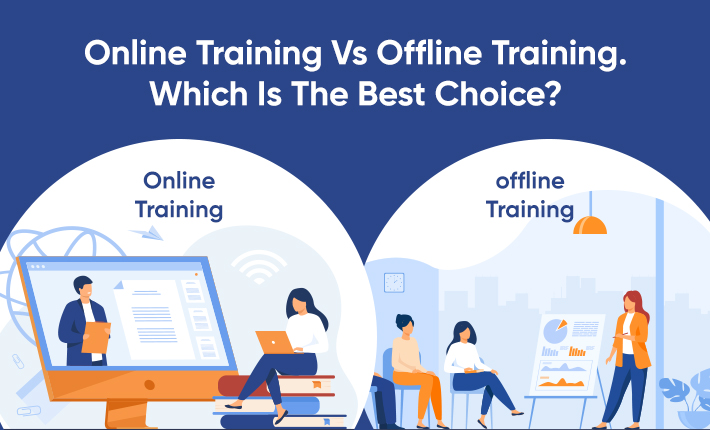The choice between online training and offline training depends on various factors, including individual preferences, accessibility, learning objectives, and resources. Both methods have their advantages and disadvantages. Here's an overview of each to help you make an informed decision.
What is Online Education?
Online education, also known as e-learning or distance learning, refers to the use of technology and the internet to deliver educational courses, programs, or training remotely. It provides students with the opportunity to access learning materials, interact with instructors, and participate in various educational activities through online platforms.
Online education typically involves the following elements:
1. Virtual Learning Platforms: Online courses are typically hosted on learning management systems or virtual platforms. These platforms serve as the central hub for course materials, assignments, assessments, and communication between instructors and students.
2. Multimedia Content: Online education utilizes a variety of multimedia elements to deliver educational content, including video lectures, audio recordings, presentations, e-books, interactive simulations, and online quizzes. These materials are often accessible at any time, allowing students to learn at their own pace.
3. Communication and Collaboration: Online education fosters interaction and collaboration between students and instructors through various means. This can include discussion forums, video conferencing, email, chat rooms, and social media groups. These communication channels enable students to ask questions, seek clarification, participate in discussions, and receive feedback from instructors and peers.
4. Assessment and Feedback: Online courses typically include methods for assessing students' progress and providing feedback on their performance. This can be done through quizzes, assignments, projects, and exams, which may be submitted online. Instructors may provide feedback electronically, allowing students to track their progress and make necessary improvements.
Online education offers several advantages, including flexibility in terms of time and location, a wide range of course options, cost-effectiveness, and the ability to learn at one's own pace. However, it also requires self-discipline and self-motivation to stay engaged and complete coursework independently.
What is Offline Education?
Offline education, also known as traditional or in-person education, refers to the traditional method of learning that takes place in a physical classroom or educational institution. It involves face-to-face interactions between instructors and students, and it relies on printed textbooks, physical materials, and direct human interaction for teaching and learning.
Here are some key features of offline education:
1. Physical Classroom Setting: Offline education takes place in a physical classroom or educational institution, where students gather to attend lectures, participate in discussions, and engage in various educational activities. This allows for direct interaction with instructors and fellow students.
2. In-Person Instruction: In offline education, instructors deliver lectures, conduct demonstrations, facilitate discussions, and provide instructions in person. This enables immediate feedback, clarification, and direct interaction between the instructor and students.
3. Printed Learning Materials: Offline education relies on printed textbooks, workbooks, handouts, and other physical learning materials that are distributed to students. These materials serve as references and resources for learning.
4. Face-to-Face Interaction: Offline education fosters direct face-to-face interaction and collaboration among students. Students can engage in discussions, group work, and peer-to-peer learning, which enhances social interaction and networking opportunities.
5. Structured Curriculum and Timelines: Offline education typically follows a structured curriculum with set timelines for completing assignments, projects, and exams. This provides a clear roadmap and ensures that students progress through the material at a consistent pace.
Offline education offers certain benefits, including immediate feedback, personalized attention from instructors, hands-on practical training (e.g., laboratory work), and networking opportunities. However, it may have limitations in terms of geographical accessibility, scheduling conflicts, and higher costs associated with commuting or living near educational institutions.
It's worth noting that the line between offline and online education has become increasingly blurred in recent years, with the integration of technology in traditional classrooms and the emergence of hybrid learning models that combine both online and offline elements.
What is the Difference Between Online and Offline Classes?
The main difference between online and offline classes lies in the mode of delivery and the learning environment. Here are some key distinctions:
Mode of Delivery:
* Online Classes: Online classes are conducted virtually through digital platforms, typically using video lectures, pre-recorded content, and online learning materials. Students access the course materials, submit assignments, and interact with instructors and classmates through online platforms.
* Offline Classes: Offline classes take place in a physical classroom setting, where instructors deliver lectures, conduct discussions, and provide instructions in person. Students attend classes in person and have direct face-to-face interactions with instructors and classmates.
Learning Environment:
* Online Classes: Online classes offer flexibility in terms of time and location. Students can access course materials and lectures at their convenience, allowing for self-paced learning. The learning environment is typically virtual, with students studying from their own location, whether it's their home, office, or any other place with internet access.
* Offline Classes: Offline classes provide a structured learning environment in a physical classroom. Students attend classes at specific times and locations, following a fixed schedule set by the educational institution. In-person interactions with instructors and fellow students allow for immediate feedback, collaboration, and networking opportunities.
Interactions and Engagement:
* Online Classes: Online classes facilitate interactions through virtual means, such as discussion forums, video conferencing, chat rooms, and email. Students and instructors may not have immediate face-to-face contact, but communication can still occur asynchronously, allowing for flexibility. Students often need self-discipline and motivation to stay engaged and complete coursework independently.
* Offline Classes: Offline classes promote direct face-to-face interactions and immediate feedback. Students can actively participate in discussions, ask questions, and engage in collaborative activities. Instructors can provide real-time explanations and clarification, fostering a more dynamic and interactive learning experience.
Learning Materials:
* Online Classes: Online classes utilize digital learning materials, including video lectures, multimedia presentations, e-books, online quizzes, and interactive simulations. These materials can be accessed and reviewed at any time, allowing for self-paced learning and repeated engagement.
* Offline Classes: Offline classes often rely on printed textbooks, handouts, and physical learning resources. Students may receive printed materials in class or access resources provided by the educational institution's library or other physical resources.
Both online and offline classes have their advantages and limitations. The choice between them depends on factors such as personal preferences, accessibility, learning objectives, and the specific requirements of the course or program. In some cases, a blended or hybrid approach that combines elements of both online and offline learning may be adopted to provide a more comprehensive educational experience.
What are the Advantages of Online Classes?
Online classes offer several advantages that make them a popular choice for many learners. Here are some key advantages of online classes:
1. Flexibility: Online classes provide flexibility in terms of time and location. Students can access course materials and lectures at their convenience, allowing them to study at their own pace. This flexibility is particularly beneficial for individuals who have other commitments, such as work or family responsibilities, as they can fit their studies around their schedule.
2. Accessibility: Online classes eliminate the barriers of geographical location. Students can access courses and educational programs from anywhere in the world, as long as they have a reliable internet connection. This accessibility allows individuals to choose from a wider range of courses and programs that may not be available locally.
3. Diverse Course Options: Online platforms offer a vast array of courses and subjects, often covering niche topics and specialized areas of study. Students have the opportunity to choose from a variety of programs offered by different institutions or instructors, expanding their learning options and allowing them to explore their specific interests.
4. Cost-Effectiveness: Online classes can be more cost-effective compared to traditional offline classes. There are often no travel expenses, accommodation costs, or other associated expenses involved in attending physical classes. Additionally, many online courses have lower tuition fees compared to offline programs, making education more affordable and accessible.
5. Self-Paced Learning: Online classes often allow students to learn at their own pace. They can review materials, pause or rewind lectures, and progress through the course based on their understanding and comfort level. This self-paced learning approach accommodates individual learning styles and preferences, promoting a personalized and effective learning experience.
6. Learning Environment: Online classes provide a comfortable and familiar learning environment for many students. They can study from the comfort of their own homes or any location of their choice, creating a relaxed and focused atmosphere conducive to learning. Additionally, online platforms often offer a variety of interactive and multimedia learning materials that can enhance engagement and retention.
7. Skill Development: Online classes promote the development of digital literacy and technical skills. Students gain experience in navigating online platforms, using digital tools, and collaborating virtually. These skills are valuable in today's digital age and can be beneficial in both personal and professional settings.
It's important to note that online classes also have challenges and may not be suitable for all types of learning or subjects. However, the advantages mentioned above make online classes an attractive option for many learners seeking flexibility, accessibility, and a diverse range of educational opportunities.
What are the Disadvantages of Online Classes?
While online classes offer many advantages, they also have certain disadvantages that should be considered. Here are some potential drawbacks of online classes:
1. Limited Face-to-Face Interaction: Online classes lack the immediate face-to-face interaction found in traditional offline classes. While communication through virtual platforms is possible, it may not provide the same level of real-time engagement and interpersonal connections as in-person interactions. This reduced interaction can impact the depth of discussions, collaborative learning, and the sense of community among students.
2. Self-Motivation and Discipline: Online classes require a high level of self-motivation and discipline. Without the structure and accountability of regular in-person classes, students need to manage their time effectively, stay organized, and remain committed to completing coursework and assignments. Some students may find it challenging to stay motivated without the in-person presence of instructors and peers.
3. Technology and Connectivity Issues: Online classes heavily rely on technology and a stable internet connection. Technical issues such as connectivity problems, software glitches, or hardware limitations can hinder the learning experience. Not all students may have access to reliable internet connections or necessary technological resources, creating barriers to participation and engagement.
4. Limited Hands-On Practical Experience: Certain subjects or disciplines require hands-on practical experience or laboratory work, which may be challenging to replicate in an online environment. Fields such as science, healthcare, or vocational training may require physical presence and access to specialized equipment, making offline classes more suitable for acquiring practical skills.
5. Potential for Distractions: Learning from home or other non-traditional settings can expose students to distractions. Noise, household responsibilities, or personal obligations may compete for attention and impact focus and concentration. Creating a dedicated study space and establishing boundaries can help mitigate these distractions.
6. Limited Networking Opportunities: While online classes provide opportunities for virtual interactions, building personal connections and networking with instructors and fellow students can be more challenging compared to offline classes. Face-to-face interactions in traditional classrooms often facilitate stronger relationships and networking opportunities that can be valuable for future career prospects.
7. Assessment and Proctoring Challenges: Online assessments and exams may raise concerns regarding integrity and cheating. Ensuring academic honesty and maintaining exam security can be more complex in an online environment. Institutions may need to employ remote proctoring technologies or alternative assessment methods to address these challenges.
It's important to note that the effectiveness of online classes can vary depending on the course content, instructional design, and the learner's personal preferences and learning style. Institutions and instructors play a crucial role in mitigating the disadvantages through effective course design, fostering online engagement, providing support, and utilizing appropriate technologies to enhance the learning experience.
What are the Advantages of Offline Classes?
Offline classes, also known as traditional or in-person classes, offer several advantages that can make them a preferred choice for certain learners. Here are some advantages of offline classes:
1. Face-to-Face Interaction: Offline classes provide immediate face-to-face interaction between instructors and students. This allows for real-time communication, immediate feedback, and the ability to ask questions and seek clarification directly. The personal presence of instructors also facilitates non-verbal cues and fosters a more engaging and dynamic learning environment.
2. Hands-On Practical Experience: Certain subjects or disciplines, such as science, engineering, fine arts, or vocational training, often require hands-on practical experience. Offline classes can provide access to laboratories, equipment, studios, or workshops, allowing students to engage in hands-on learning, experiments, and skill development that may be challenging to replicate in an online environment.
3. Networking and Social Interaction: Offline classes provide opportunities for networking and social interaction with instructors and fellow students. Building personal connections, participating in group discussions, collaborating on projects, and engaging in extracurricular activities or campus events can enhance the overall learning experience and create valuable professional networks.
4. Structured Learning Environment: Offline classes often follow a structured curriculum with fixed schedules, assignments, and deadlines. This structure helps students stay organized, maintain a consistent learning pace, and provides a sense of accountability. The presence of a physical classroom and regular attendance can also contribute to a disciplined approach to learning.
5. Immediate Feedback and Clarification: In-person classes allow for immediate feedback and clarification. Instructors can address questions, misconceptions, or areas of difficulty in real-time, promoting a deeper understanding of the subject matter. Students can seek immediate clarification, engage in discussions, and benefit from the expertise and guidance of the instructor.
6. Access to Physical Learning Resources: Offline classes often provide access to physical learning resources such as libraries, books, journals, and specialized facilities or equipment. Physical resources can enhance the learning experience by allowing students to explore a variety of reference materials and engage in research or independent study.
7. Personalized Attention: In offline classes, instructors can observe and understand individual learning styles, strengths, and weaknesses more easily. They can adapt their teaching methods, provide personalized guidance, and offer tailored support to students, which can be especially beneficial for those who may need extra attention or assistance.
Offline classes have their own set of advantages, particularly in terms of immediate interaction, hands-on learning, and social connections. However, it's important to consider factors such as geographical accessibility, scheduling constraints, and associated costs when evaluating the suitability of offline classes for specific learning needs and preferences.
What are the Disadvantages of Offline Classes?
While offline classes offer several advantages, they also come with certain disadvantages that should be considered. Here are some potential drawbacks of offline classes:
1. Geographical Constraints: Offline classes require physical presence, which can be limiting for individuals who live far away from educational institutions or face mobility challenges. This can result in limited access to specific courses or programs, leading to reduced educational opportunities for some learners.
2. Time and Schedule Constraints: Offline classes often follow fixed schedules, requiring students to attend classes at specific times. This can pose challenges for individuals with conflicting commitments, such as work, family responsibilities, or other personal obligations. The rigid schedule may limit flexibility and make it difficult for some students to balance their various responsibilities.
3. Higher Costs: Offline classes can be more expensive compared to online classes. Students may incur costs related to commuting, accommodation near the educational institution, or additional expenses associated with in-person learning, such as laboratory fees or access to specialized facilities. These costs can be a barrier for individuals with limited financial resources.
4. Limited Course Options: Offline classes are dependent on the availability of courses offered by local educational institutions. This can result in limited course options, especially for specialized or niche subjects. Students may have to compromise on their preferred courses or make arrangements to travel to institutions that offer the desired programs.
5. Reduced Flexibility: Offline classes have less flexibility compared to online classes. Students are required to adhere to the fixed schedules and may have limited control over the pace of learning. This can be challenging for individuals who prefer a more self-directed and flexible approach to their education.
6. Limited Access to Digital Resources: Offline classes may have limited access to digital resources and online databases. While physical libraries and resources may be available, they may not provide the same breadth and depth of digital materials and online research tools that are easily accessible in online learning environments.
7. Inefficient Learning Pace: In an offline classroom, instructors need to consider the pace of the entire class, which may result in either a slower or faster pace than some students would prefer. This can affect the individual learning experience, as some students may feel held back or rushed through the material.
It's important to note that the effectiveness of offline classes can vary depending on the teaching methods, instructor expertise, and the specific needs and preferences of the learners. Institutions and instructors can mitigate some of the disadvantages by offering blended learning models that incorporate both offline and online elements, thus combining the benefits of both approaches.





Leave a reply